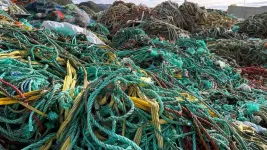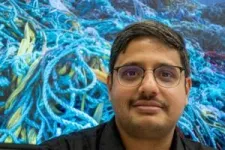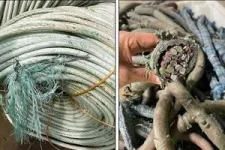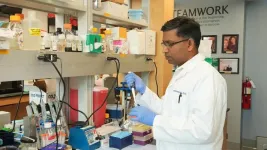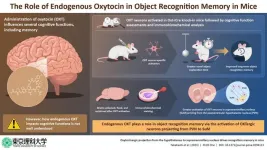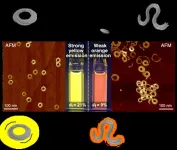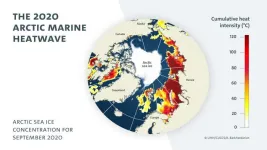(Press-News.org) Lost fishing lines and ropes are a growing problem. As a leading fishing nation, Norway, with its long coastline and fish-rich waters, is particularly vulnerable to marine litter. A new study from the Norwegian University of Science and Technology (NTNU) shows that only a third of all ropes produced and sold in Norway can be recycled in a sustainable way.
The rest are burned, buried, sent out of the country - or just pile up and contribute to something called ghost fishing. That's when lost or abandoned fishing gear, floating in the ocean or anchored to the bottom, inadvertently continues to catch marine creatures long after it was in commercial use.
First study with statistics on ropes
“Norway is heavily dependent on the blue economy, and finding solutions is becoming increasingly urgent. Without the responsible handling of ropes, the fisheries sector will never be green or sustainable,” says Paritosh Deshpande, an associate professor at NTNU’s Department of Industrial Economics and Technology Management.
He studies plastic litter in the ocean, and is the first person to establish how much rope is lost and how the Norwegian fisheries sector handles ropes.
Goal: new sustainability policy
The researchers have analysed 15 types of rope widely used by professional fishermen in Norway. They have also ranked the rope according to how easy or difficult it is to recycle.
The goal is to develop new knowledge and tools that can contribute to less litter, more recycling and increased sustainability. Deshpande’s statistics have been used by the UN Environment Programme and other agencies in the UN, the EU system, the Norwegian Environment Agency and others working on policy in this area.
The largest rubbish dump in the world
Only in the last decade have we realized that we have made the oceans the world’s largest rubbish dump. An article in Science estimates that between 5 and 13 million tonnes of plastic end up in the oceans each year, but there is no global data on how much of that comes from marine industries.
Same product - different content
For several years, Deshpande has collected data from Norwegian suppliers, manufacturers, dealers, fishermen, waste disposal sites, recycling companies and authorities. The collection has been repeated several times to remove uncertainty and ensure that the data are correct.
What he sees is that different manufacturers make the same types of rope and fishing gear, but in different ways and out of different materials. Many manufacturers don’t know exactly what kind of or how many different plastics their ropes contain. The methods vary, and imported raw materials may lack content labelling.
“If you buy a bottle of water, you can find out exactly how much calcium and magnesium it contains. You don’t get this kind of information when you buy fishing rope,” he points out.
Three categories of rope and three colours
An overview of the 15 most used ropes shows what they are made of, how they are made, what they are used for, and any special characteristics they have. The researchers have divided the ropes into three categories, with easy-to-understand traffic light colours according to their recyclability.
The first step towards a labelling scheme?
This could be the first step towards a labelling scheme where manufacturers divide ropes into categories. Labelling can contribute to used ropes being treated more as a valuable resource, the researchers believe.
Other measures may include:
Research and innovation for more eco-design and recyclability
Smarter return schemes
Best-practice schemes for handling ropes
Increased efforts to get plastic manufacturers to use recycled plastics
“Manufacturers, fishermen, authorities, waste disposal sites and recycling companies. All of them can be part of the solution, and none of them can do it alone. This also involves UN Sustainable Development Goal number 17, which is about us only being able to achieve the goals if we work together,” Deshpande says.
Uncertainty and cause for concern
Waste is dangerous to wildlife that lives in and by the sea. It traps, injures and kills – and enters the food chains.
Deshpande is working to ascertain the scope of this, with Norway and the Norwegian fisheries sector as his starting point. He believes that if we are to make a green shift in the blue industry, the production cycle must be closed and the hazardous waste moved into a circular economy. In a circular economy, products must last as long as possible, be repaired, upgraded and be reused to a greater extent. When products cannot be reused, the waste material can be recovered and used as raw material in new production. In this way, the same resources can be used several times and as few as possible are lost.
To do that, we need to know what kind of plastic has gone astray, and how much is available for recycling.
“We then need to ensure that the possible solutions are environmentally friendly, socially acceptable and feasible,” he says.
Macabre fishing
In 2019, Deshpande and his colleagues published an article about the most deadly plastic waste that ends up in the ocean: fishing gear that has been forgotten, abandoned or lost.
“We conducted a material flow analysis that showed that almost 400 tonnes of this type of waste from the Norwegian fisheries sector end up in the sea every year,” says Deshpande.
A material flow analysis is a systematic assessment of flows and inventories of materials within a given system defined in space and time. Having good documentation of material flows is a prerequisite for good resource and environmental management of given substances or materials.
Crab pots, long lines, nets and fish pots get left on the seabed and continue to catch fish and other sea creatures. This macabre form of fishing can continue year after year.
In the long run, this littering also means that the fisheries end up undermining their own industry.
Rope was not included in this study, but it is the focus of Deshpande's recent article, published in the Marine Pollution Bulletin. Studies also need to be conducted into how much the fish farming industry contributes to the problem.
Deshpande says that the figures they have indicate that Norwegian fishermen fill Norwegian waters with almost 800 tonnes of plastic fishing gear and ropes – every single year.
Advice to the United Nations
Deshpande’s method and models have been adopted in other countries, such as Taiwan. He is also a member of WG-43, a work group in GESAMP – the Joint Group of Experts on the Scientific Aspects of Marine Environmental Protection. The group consists of independent scientific experts who map and analyse littering from fisheries and shipping, and advise the UN system on marine environmental protection.
“We received a serious amount of attention when WG-43 flagged the need for more knowledge about plastic-related problems in 2021. The world is finally waking up,” Deshpande said.
Tip of the iceberg
The computer models follow the life cycle of the materials from when they are extracted as raw materials, through being put into production, used and maintained, until they are finally discarded.
“The figures produced by these models always have a certain amount of uncertainty associated with them, and we take that into account. No such calculations have been made for plastic in ropes in Norway before,” Deshpande said.
“The point is not to get numbers that are correct right down to the last decimal place; we are measuring rubbish, not gold. The point is to have fewer ropes ending up in the sea and getting more rope into sustainable circulation,” he said.
However, this is just the tip of the iceberg. The study did not include recreational fishing, fish farming or foreign fishing fleets.
Rope is a hard challenge to untangle
Recycling rope is particularly challenging because there are so many different types. They can be made from many different materials and have very different characteristics.
They are used for mooring, trawling, towing, anchoring and lifting. Some consist of only one type of plastic, while others may contain several types that may even have different melting points. Rope can be braided with copper wire, or have steel wire in its core. Some types float, while others have lead in them to make them sink.
The mountain of rubbish that keeps on growing
Every summer for the last 40 years, the Norwegian Directorate of Fisheries has carried out a cruise in Norwegian waters to collect lost fishing gear. In addition, there are divers, clean-up operations and campaigns that clean fjords and beaches.
“It is only in the last decade that the clean-up operations have really intensified, whereas commercial fishing has been going on for many decades. There is a lot of rubbish out there. We need to prevent marine littering from happening and find out how best to avoid its increase,” says Deshpande.
Not in compliance with EU directive
The EU’s Directive on Ship-source Pollution states that the more than 4400 small and large ports along the Norwegian coast must have reception facilities for rope and fishing gear from ships. When only one in three ports has such reception facilities, it leads to illegal dumping, illegal burning, and fishing gear being left on land without being properly processed.
The figures from NTNU show that approximately 2700 tonnes of discarded rope end up at reception facilities.
Lack of capacity and equipment
The discarded rope that comes in is often in a shocking condition, tangled and soiled with rotten biomass, fish oil and sand. Recycling companies do not have the appropriate cleaning equipment, and many find that recycling becomes technologically and economically impossible.
Norway lacks both systems and capacity for collection, and technology and equipment for recycling. As a result, more than half of the ropes and fishing gear that are delivered to reception facilities is incinerated or ends up in landfill.
The rest, much of it fully recyclable, is sent abroad for recycling.
Companies such as Nofir and Oceanize are leading actors in Norway, and ensure that waste is collected and assets are recycled. However, more people are needed to solve the problems,” says Deshpande.
Taking responsibility for our own waste
Deshpande says we do not know for sure how the ropes are processed when they are sent out of the country.
“It is our responsibility to manage the waste we create ourselves, or to ensure that the reception facilities process it the way we expect it should be when we export it.
In addition, when we send the waste out of the country, we lose the opportunity to create value from local resources,” says the NTNU researcher.
The EU has demanded that Norway introduces extended producer responsibility for equipment containing plastic from fisheries, aquaculture and recreational fishing by 31 December this year. This imposes responsibility on manufacturers for the products throughout their life cycle, from the design of the products until they become waste and the materials are used as secondary raw materials in new products. This means that the cost of waste management is included in the price of the product, in accordance with the polluter pays principle.
Norway must lead the way
Deshpande says he has learned a lot from the industry. He believes Norway is one of the countries in the world that must lead the way in developing knowledge that helps bring an end to marine littering.
He believes we can do it; awareness in the sector has increased and more focus is being placed on research. Most people get upset and angry at the sight of gannets sitting on nests of nylon ropes, and whales drifting ashore with their stomachs full of plastic.
References:
Paritosh C. Deshpande, Sidra Tul Muntaha, Ragnhild Bjerkvik Alnes. 2023.
“Multi-stakeholder perspective to generate evidence and strategies for sustainable management of ropes from the fishing sector of Norway”
Marine Pollution Bulletin. Volume 197, December 2023, 115798
https://doi.org/10.1016/j.marpolbul.2023.115798
END
If we can't untangle this mess, Norway's blue industry will never be green
One recent study estimates that the total amount of fishing line lost annually could stretch from the moon and back. A new study from Norway shows that roughly one-third of lines could be recycled
2024-02-13
ELSE PRESS RELEASES FROM THIS DATE:
National Foundation for Cancer Research (NFCR) celebrates Dr. Yung-Chi Cheng's three decades of pioneering research and recent partnership with Astrazeneca China
2024-02-13
The National Foundation for Cancer Research (NFCR) proudly celebrates the outstanding contributions of Dr. Yung-Chi Cheng, the Henry Bronson Professor of Pharmacology and Medicine at Yale University. Dr. Cheng's relentless dedication over the past three decades has led to an experimental botanical drug, YIV-906, to enter various phase II human trials and establishing a now clinical-stage platform biotechnology company committed to developing groundbreaking medicines targeting cancer and aging-related diseases.
NFCR has been a vital and steadfast supporter of Dr. Cheng's pioneering work, providing more than $2.5 MM ...
Sandalwood oil by-product prevents prostate cancer development in mice
2024-02-13
Extracted from the core of sandalwood trees (santalum album tree), sandalwood oil has been used for many centuries by several cultures throughout the world for perfume, soaps, incense and candles. With its earthy sweet scent, this essential oil also is used in the food industry and topically in various cosmetic preparations.
Importantly, this natural oil is known for its health benefits and medicinal applications from antibacterial to anticancer because of its phytochemical constituents. In addition to containing esters, free acids, aldehydes, ketones and santenone, sandalwood oil primarily (90 percent or more) constitutes santalol – ...
Low-cost microbe can speed biological discovery
2024-02-13
UNDER EMBARGO UNTIL 8AM EST ON FEB. 13, 2024
ITHACA, N.Y. – Cornell University researchers have created a new version of a microbe to compete economically with E. coli – a bacteria commonly used as a research tool due to its ability to synthesize proteins – to conduct low-cost and scalable synthetic biological experiments.
As an inexpensive multiplier – much like having a photocopier in a test tube – the bacteria Vibrio natriegens could help labs test protein variants for creation of pharmaceuticals, synthetic fuels and sustainable compounds that battle weeds or pests. The microbe can work effectively without costly incubators, shakers or deep freezers ...
Determining who gets blamed when cars hit pedestrians
2024-02-13
COLUMBUS, Ohio – A new study examines the circumstances behind who is found at fault when cars hit pedestrians in an urban area.
Results showed that the environment where the crash took place – especially the types of roads and the amount of access to marked crosswalks – played a key role in whether the pedestrian or the driver was blamed for the collision.
In the study, done in Columbus, pedestrians were more likely to be blamed when they were crossing roads with a high volume of cars traveling at faster speeds, and where crosswalks were few and far between.
In areas of the city – such as downtown – ...
Oxytocin: the love hormone that holds the key to better memory
2024-02-13
Oxytocin (OXT) is a hormone that is known for its effects on psychological well-being and emotional bonding in animals. Interestingly, research has shown that this natural chemical in the brain plays a crucial role in other cognitive processes as well, including learning and memory. Now, scientists may have discovered exactly how OXT influences memory in animals by studying “OXT neurons” that contain OXT receptors and function differently based on the availability of the chemical in the brain.
In a recent study published on 16 November 2023, in PLOS One, a group ...
Exploring the effect of ring closing on fluorescence of supramolecular polymers
2024-02-13
In supramolecular chemistry, the self-assembly state of molecules plays a significant role in determining their tangible properties. Controlling the self-assembled state has garnered significant attention as it can be exploited to design materials with desired properties like charge transport capability and fluorescence wavelength. For years, scientists have been trying to decipher how molecular organization impacts the properties of supramolecular assemblies that are in the nano (<10 nm) and mesoscopic (10–1000 nm) scales. However, the study of structures with supramolecular polymer assemblies derived from the same monomer is often hindered by dynamic structural ...
Frequent marine heatwaves in the Arctic Ocean will be the norm
2024-02-13
Marine heatwaves will become a regular occurrence in the Arctic in the near future and are a product of higher anthropogenic greenhouse-gas emissions – as shown in a study just released by Dr. Armineh Barkhordarian from Universität Hamburg’s Cluster of Excellence for climate research CLICCS.
Since 2007, conditions in the Arctic have shifted, as confirmed by data recently published in the journal Nature Communications Earth & Environment. Between 2007 and 2021, the marginal zones ...
Greenland’s ice sheet is melting - and being replaced by vegetation
2024-02-13
University of Leeds Press Release
Under embargo until 10:00 GMT on 13 February
There are graphics and photographic images that help explain this story – see under Note to editors
Greenland’s ice sheet is melting - and being replaced by vegetation
An estimated 11,000 sq miles or 28,707 sq kilometres of Greenland’s ice sheet and glaciers have melted over the last three decades, according to a major analysis of historic satellite records.
The total area of ice loss is equivalent to the size of Albania, and represents about 1.6 % of Greenland’s ...
New Durham University research opens avenues for more efficient and stable blue OLED displays
2024-02-13
-With pictures-
A new research from scientists at Durham University reveals an unexpected pathway towards brighter, more efficient, and more stable blue organic light-emitting diodes (OLEDs).
The findings, published in the journal Nature Photonics could help enable the next generation of energy-saving display technologies.
OLED displays, used in most modern smartphones and TVs, rely on light emission from specialised organic molecules.
Obtaining stable, efficient blue emission suitable for displays remains a key challenge.
Now, Durham ...
Study finds childhood bullying linked to distrust and mental health problems in adolescence
2024-02-13
A new study, co-led by UCLA Health and the University of Glasgow, found that young teenagers who develop a strong distrust of other people as a result of childhood bullying are substantially more likely to have significant mental health problems as they enter adulthood compared to those who do not develop interpersonal trust issues.
The study, published in the journal Nature Mental Health on Feb. 13, is believed to be the first to examine the link between peer bullying, interpersonal distrust, and the subsequent development of mental health problems, such as anxiety, depression, hyperactivity and anger.
Researchers ...
LAST 30 PRESS RELEASES:
Why nail-biting, procrastination and other self-sabotaging behaviors are rooted in survival instincts
Regional variations in mechanical properties of porcine leptomeninges
Artificial empathy in therapy and healthcare: advancements in interpersonal interaction technologies
Why some brains switch gears more efficiently than others
UVA’s Jundong Li wins ICDM’S 2025 Tao Li Award for data mining, machine learning
UVA’s low-power, high-performance computer power player Mircea Stan earns National Academy of Inventors fellowship
Not playing by the rules: USU researcher explores filamentous algae dynamics in rivers
Do our body clocks influence our risk of dementia?
Anthropologists offer new evidence of bipedalism in long-debated fossil discovery
Safer receipt paper from wood
Dosage-sensitive genes suggest no whole-genome duplications in ancestral angiosperm
First ancient human herpesvirus genomes document their deep history with humans
Why Some Bacteria Survive Antibiotics and How to Stop Them - New study reveals that bacteria can survive antibiotic treatment through two fundamentally different “shutdown modes”
UCLA study links scar healing to dangerous placenta condition
CHANGE-seq-BE finds off-target changes in the genome from base editors
The Journal of Nuclear Medicine Ahead-of-Print Tip Sheet: January 2, 2026
Delayed or absent first dose of measles, mumps, and rubella vaccination
Trends in US preterm birth rates by household income and race and ethnicity
Study identifies potential biomarker linked to progression and brain inflammation in multiple sclerosis
Many mothers in Norway do not show up for postnatal check-ups
Researchers want to find out why quick clay is so unstable
Superradiant spins show teamwork at the quantum scale
Cleveland Clinic Research links tumor bacteria to immunotherapy resistance in head and neck cancer
First Editorial of 2026: Resisting AI slop
Joint ground- and space-based observations reveal Saturn-mass rogue planet
Inheritable genetic variant offers protection against blood cancer risk and progression
Pigs settled Pacific islands alongside early human voyagers
A Coral reef’s daily pulse reshapes microbes in surrounding waters
EAST Tokamak experiments exceed plasma density limit, offering new approach to fusion ignition
Groundbreaking discovery reveals Africa’s oldest cremation pyre and complex ritual practices
[Press-News.org] If we can't untangle this mess, Norway's blue industry will never be greenOne recent study estimates that the total amount of fishing line lost annually could stretch from the moon and back. A new study from Norway shows that roughly one-third of lines could be recycled
